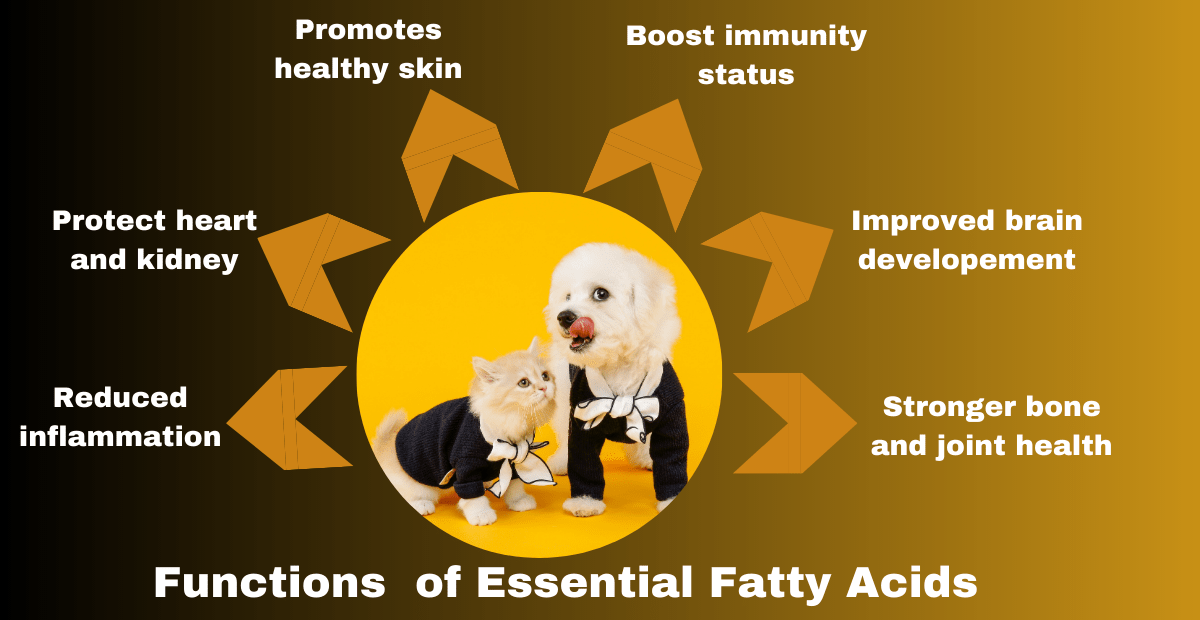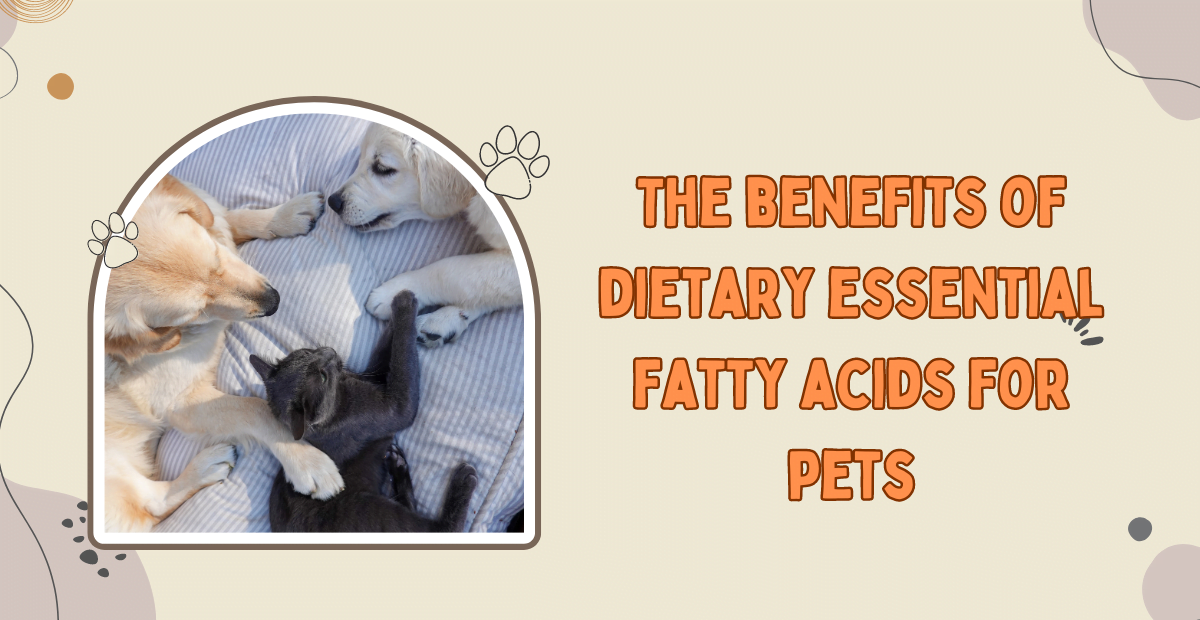Last updated on January 26th, 2024 at 06:09 am
Essential fatty acids: Is it truly necessary for your animals?
Essential fatty acids (EFAs) are the most effective supplements you can give your pets. They can offer a wide range of beneficial impacts on animal health, according to several research. So, due to the supplementation of EFAs in the diet of your pet animals, they can improve brain development, stronger the immune systems, reduced bone-related problems, and also improved skin texture, etc.
The body cannot synthesize essential fatty acids, thus humans and other animals must consume them in order to maintain optimum health. Alpha-linolenic acid (an omega-3 fatty acid) and linoleic acid (an omega-6 fatty acid) are the only fatty acids proven to be crucial for human as well as animal health. The types of EFAs are given below in Table 1.
Table 1: Types of essential fatty acids
| Omega-3 fatty acids include | Omega-6 fatty acids include: |
| Alpha-linolenic acid (ALA) | Linoleic acid (LA) |
| Eicosapentaenoic acid (EPA) | Gamma linolenic acid (GLA) |
| Docosahexaenoic acid (DHA) | Dihomo-gamma-linolenic acid (DGLA) |
| Arachidonic acid (AA) |
Alpha-linolenic acid (ALA,), eicosapentaenoic acid (EPA), and docosahexaenoic acid (DHA) are the three important omega-3 fatty acids. Phytoplankton and other marine plants, as well as fish oil, are the main sources of EPA and DHA.
Linoleic acid (LA) and arachidonic acid (AA) are the two important omega-6 fatty acids. While AA is necessary solely for cats, LA is necessary for both dogs and cats. Because cats lack the enzyme delta-6 desaturase, which is necessary for the endogenous conversion of LA to the longer, more unsaturated fatty acid AA, cats must consume AA.
The NRC mentions dietary needs for EPA and DHA for both dogs and cats because of the poor conversion of ALA to EPA and DHA1. But the needs differ according to the stage of life; for instance, developing puppies and kittens need more DHA than do mature dogs and cats. Lack of omega-3 fatty acids may cause neurologic problems, such as deteriorated visual acuity.
What Benefits Can Dogs/cats Expect from Essential Fatty Acids?
1. Improved healthy skin and hair
Your pets needs the EFAs in natural as well as in supplements to maintain a healthy hair and skin coat. Omega-3 and Omega-6 are known to keep your pet’s skin and coat moisturized, encourage healthy hair development, and prevent dry and itchy skin. Essential fatty acids can also aid in the treatment of your pet’s more severe skin issues, such as dermatitis, balding patches, hot spots, and other skin irritations.
2. Enhance and promote brain function
Compounds like docosahexaenoic acid (DHA) and eicosapentaenoic acid (EPA) are found in EFAs and are required for brain development. There is evidence that DHA and EPA can assist canine cognitive function, and there is a link between essential fatty acids and improved puppy trainability.
For pups, adult dogs, and senior dogs alike, essential fatty acids have been found to have positive effects on brain function. The attention, trainability, and memory of your dog can all be supported by a diet high in EFAs, which can also assist to lessen the symptoms of cognitive decline in older pets.

Fig: Benefits of essential fatty acids for pets
3. Strengthen Joint Health
For dogs to maintain robust and healthy joints, EFAs are a crucial element. For pet joints to stay mobile and flexible, essential fatty acids are just as crucial as they are for humans. Deficiency of EFAs in the diet of your pets causes future issues like arthritis and joint degeneration.
Omega-3 and Omega-6 can promote the mobility, flexibility, and strength of your pet’s joints and even aid to reduce inflammation and hasten the healing of joint injuries. The dog owners who participated in some of the trials agreed that adding omega-3 fats to their dogs’ diets greatly reduced pain, lameness, and joint severity.
You might want to think about putting supplements containing EFAs in your loved one (pet’s) food if they have joint problems. Consult your veterinarian to determine the right essential fatty acid supplement type and dosage for your pet. This can involve changing to a healthier dog food brand that will give them the daily vital fatty acids they need or deciding to buy a Hip & Joint Daily Supplement to offer more advantages.
4. Enhancing pet’s immune systems
Improper immunity may cause several types of disorders in pet animals. So, food that enhance the immune status of our pet that must be included in their diet. Omega-3 fatty acids, which are high in EPA and DHA, have been found to benefit a pet’s immune system when added to the diet, according to research. Effects have been reported on everything from significantly increased antibody titers following immunizations to reducing the adverse effects of allergies brought on by an overly responsive immune system2.
5. Enhancing the health of canine kidneys and the heart
Numerous research on dogs of all sexes, breeds, ages, sizes, and weights have demonstrated the significant benefits of EFAs (omega-3) on canines with various heart diseases. The advantages include increased heart health and hunger, lowered blood pressure, reduced inflammation, and lessened muscle loss. These canines reported greater survival times than the canines who did not get omega-3 fatty acids3.
6. Assisting canines by lowering stress, sadness, and hyperactivity
The addition of EFAs may help your pet if it struggles with anxiety, despair, or hyperactivity.
Although the specific mechanism by which EFAs influence behavior is unknown, it has been shown that they alter neurotransmitters and have an impact on neuroplasticity. In fact, it has been discovered that fatty acids have the same effects on anxiety-related pathways as anti-anxiety drugs most notably fluoxetine, a drug that is frequently recommended to treat anxiety problems in dogs4. It was reported that EFAs were also recommended in case of some nervous disorder (epilepsy) by veterinarians.
Sources of suitable essential fatty acids for dogs/cats
Plant-based oils, such as canola, flaxseed, corn, and soybean oils, are sources of LA and ALA. Animal fat normally has the most AA, with plant oils and seeds typically containing little to no AA5 (Table 2). Advice for including a sufficient quantity of omega-3 fatty acids in a pet’s diet: Avoid taking supplements that are packed in pills or capsules and instead opt for natural sources like fish, flax seed oils, or entire flax seeds. Utilize recent sources whenever possible. Oils can easily go rancid, especially ones with omega-3 fatty acids.
Table 2 Provides information on common oils used in pet food, including their source and serving size
| Name of EFAs | Source | Serving size |
| Ground flaxseed | Natural | Toy-Miniature Dogs: 1/8–1/4 teaspoon (tsp) Small Dogs: 1/4 tsp –1 tsp Medium Dogs: 1 1/2 tsp–1 tsp Large-Giant Dogs: 1–2 tsp |
| Chia seed | Natural | Toy-Miniature Dogs: 1/8–1/4 tsp Small Dogs: 1/4 tsp –1 tsp Medium Dogs: 1 1/2 tsp–1 tsp Large-Giant Dogs: 1–2 tsp |
| Coconut oil | Natural | 1 tsp/5kg body weight |
| Hempseed oil | Natural | 1 tsp/ 5kg body weight |
| Skinned salmon fish | Natural | 3 oz |
| Cod fish with skin | Natural | 3 oz |
| Crab | Natural | 3 oz |
| Fish oil Anchovy Oil Herring Oil Mackerel Oil Sardine Oil | Natural/Synthetic | Toy-Miniature Dogs: 0–15 lbs: ½ pump Small Dogs: 15–25 lbs: 1 pump Medium Dogs: 25–50 lbs: 2 pumps Large Dogs: 50–75 lbs: 3 pumps Giant Dogs: 75+lbs: 4 pumps |

The recommended dietary requirement of essential fatty acids for pets
It is advised that all pet food contain essential fatty acids. The NRC publishes minimum criteria for total fat, LA, ALA (except for adult cats), EPA + DHA, and AA, while the AAFCO nutritional profiles provide minimum needs for crude fat concentration, LA, ALA, AA (for cats only), and EPA + DHA in pet food5,6. Table 3 is a list of these minimal needs.
Table 3: Essential Fatty Acids Minimum Requirements for pets (g/1000 Kcal)5,6
| DOGS (Growth) | DOGS (Adult Maintenance) | CATS (Growth) | CATE (Adult Maintenance) | |
| Total Fat | ||||
| NRC RA | 21.3 | 13.8 | 22.5 | 22.5 |
| AAFCO | 21.3 | 13.8 | 22.5 | 22.5 |
| Linoleic Acid | ||||
| NRC RA | 3.3 | 28 | 1.4 | 1.4 |
| AAFCO | 3.3 | 28 | 1.4 | 1.4 |
| Arachidonic Acid | ||||
| NRC RA | 0.08 | ND | 0.05 | 0.015 |
| AAFCO | ND | ND | 0.05 | 0.05 |
| Alpha-linolenic Acid | ||||
| NRC RA | 0.2 | 0.11 | 0.05 | ND |
| AAFCO | 0.2 | ND | 0.05 | ND |
| Eicosapentaenoic Acid + Docosahexaenoic Acid | ||||
| NRC RA | 0.13 | 0.11 | 0.025 | 0.025 |
| AAFCO | 0.1 | ND | 0.03 | ND |
What does fatty acid deficit in pet animals mean?
Dogs fed on overcooked, spoiled, poorly stored, or food with insufficient antioxidant levels may have EFA deficits, which are uncommon to rare. The clinical symptoms of EFA deficiency include infertility, scaly skin, poor coat condition, and slow growth. Therefore, you should always examine the quality of the food given before feeding it to your pet. Food that is being offered must be abundant in both macro and micronutrients.
What is the remedy for a deficiency in essential fatty acids?
Both oral and parenteral administration of essential fatty acids is possible. Sunflower oil applied topically has been used in a few cases to treat an essential fatty acid shortage, although not all patients respond well to topical replacement. Since there are both natural and synthetic EFAs available on the market (sources are listed in the table), you should supplement your pet’s food if a deficiency might develop.
What negative consequences can pets experience from EFAs?
In general, essential fatty acids are quite secure. Diarrhoea, vomiting, delayed wound healing, tiredness, a fishy smell on the breath or skin, increased itching, or an oily coat and skin flakes are possible side effects, especially at high doses. If the supplement is stopped, these negative effects should go away.
What fatty acid is the most dangerous?
Tran’s fat, also known as “trans fatty acids,” is a term used to describe the partially hydrogenated vegetable oils that are used in many meals. These are unhealthy fats for you and also for your pets. Artificial trans fats in the diet increase cholesterol levels and the risk of heart attack, stroke, and even diabetes. Fried meals, margarine, non-dairy coffee creamer, etc. are a few examples of foods high in harmful fatty acids.
Read More: Should I Add Water to Dry Dog Food ?
References
- Bauer JE. Metabolic basis for the essential nature of fatty acids and the unique dietary fatty acid requirements of cats. JAVMA 2006; 229(11):1729-1732.
- Zicker SC, Jewell DE, Yamka RM, et al: Evaluation of cognitive learning, memory, psychomotor, immunologic, and retinal functions in healthy puppies fed foods fortified with docosahexaenoic acid-rich fish oil from 8 to 52 weeks of age. Journal of the American Veterinary Medical Association; 2012, 241(5): 583-94.
- Slupe JL, Freeman LM, Rush JE: Association of Body Weight and Body Condition with Survival in Dogs with Heart Failure. Journal of Veterinary Internal Medicine; 2008; Vol. 22, Iss. 3, pp 561-563.
- Heinze CR: The Skinny on Fat: Part 2 – Essential fatty acids and inflammation. Cummings School of Veterinary Medicine; 2018.
- National Research Council. Nutrient requirements and dietary nutrient concentrations. Nutrient Requirements of Dogs and Cats. Washington, DC: The National Academies Press, 2006, pp 354-370.
- Association of American Feed Control Officials. Model bill and regulations. 2016 Official Publication. Champaign, IL: Association of American Feed Control Officials, Inc, 2016, pp 107-240.
FAQs
How much fatty acids need a dog to consume per day?
Dogs and cats specifically benefit from EPA and DHA essential fatty acids. The daily recommendations for EPA and DHA are 40 mg/kg of body weight for EPA and 25–30 mg/kg of body weight for DHA. About 1000 mg of EPA is required daily for a 50-pound dog.
Is it okay to give my dog human omega-3?
It’s advisable to avoid feeding your dog a supplement made for human consumption, even if fish oil and omega-3 are safe and advantageous for dogs. There are a tonne of EFAs supplements available that are made exclusively for dogs, so there’s really no reason to give your dog something that is intended for people.
Is coconut oil safe for our pets to eat?
Although coconut oil is typically safe for your pets, some canines may react negatively to the supplement. Too much coconut oil in a pet’s die can also cause diarrhoea. Due to its high fat content, coconut oil poses a risk to dogs that are predisposed to pancreatitis.
Do eggs contain omega-3 fatty acids?
Every egg contains some omega-3 fatty acids from the birds’ normal diet, or about 25 mg of DHA and ALA each. The amount in eggs is insignificant because studies on the health benefits of omega-3 fatty acids recommend consuming 500 to 1000 mg of DHA and EPA together.
Is fish oil safe to feed to my pet every day?
Your veterinarian may advise giving your dog a daily fish oil supplement, even though other dogs may just require an occasional fish oil supplement to help maintain their omega-3 levels up.
WRITTEN BY
Dr. Lamella Ojha, Ph. D. (Animal Nutrition), Veterinarian
Dr. Lamella Ojha is an accomplished veterinarian with years of expertise in the disciplines of veterinary medicine, writing, editing, and consulting…




